 W
WSholicola is a genus of bird in the family Muscicapidae that was erected in 2017. They are commonly referred to as sholakilis. The two species placed in this genus endemic to the montane grassland and cloud forest complex known as sholas in southern India:Nilgiri blue robin White-bellied blue robin
 W
WThe dark-fronted babbler is an Old World babbler found in the Western Ghats of India and the forests of Sri Lanka. They are small chestnut brown birds with a dark black cap, a whitish underside and pale yellow iris. They forage in flocks in the undergrowth of forests constantly making calls and uttering alarm calls when disturbed.
 W
WThe rufous babbler is an endemic species of bird found in the Western Ghats of southern India of the family Leiothrichidae It is dark brown and long tailed, and is usually seen foraging in noisy groups along open hillsides with a mixture of grass, bracken and forest.
 W
WThe yellow-billed babbler is a member of the family Leiothrichidae endemic to southern India and Sri Lanka. The yellow-billed babbler is a common resident breeding bird in Sri Lanka and southern India. Its habitat is scrub, cultivation and garden land. This species, like most babblers, is not migratory, and has short rounded wings and a weak flight and is usually seen calling and foraging in groups. It is often mistaken for the jungle babbler, whose range overlaps in parts of southern India, although it has a distinctive call and tends to be found in more vegetated habitats. Its name is also confused with T. leucocephala, which is also known as white-headed babbler.
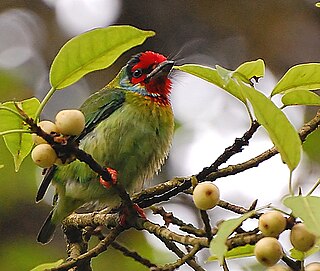 W
WThe Malabar barbet is an Asian barbet native to the Western Ghats in India. It was formerly treated as a race of the crimson-fronted barbet. It overlaps in some places with the range of the coppersmith barbet and has a similar but more rapid call.
 W
WThe white-cheeked barbet or small green barbet is a species of barbet found in southern India. It is very similar to the more widespread brown-headed barbet but this species has a distinctive supercilium and a broad white cheek stripe below the eye and is endemic to the forest areas of the Western Ghats and adjoining hills. The brown-headed barbet has an orange eye-ring but the calls are very similar and the two species occur together in some of the drier forests to the east of the Western Ghats. Like all other Asian barbets they are mainly frugivorous although they may sometimes eat insects and they use their bills to excavate nest cavities in trees.
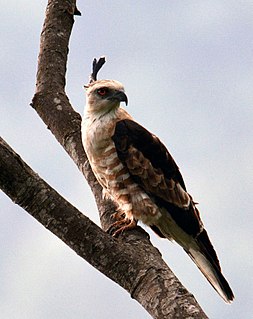 W
WJerdon's baza is a moderate sized brown hawk with a thin white-tipped black crest usually held erect. It is found in South-east Asia. It inhabits foothills in the terai and is rarer in evergreen forests and tea estates.
 W
WThe flame-throated bulbul is a member of the bulbul family of passerine birds and the state bird of Goa. It is found only in the forests of the Western Ghats in southern India. Formerly included as a subspecies of Pycnonotus flaviventris it has since been elevated to the status of a full species. They are olive backed with yellow undersides, a triangular orange-red throat and a white iris that stands out against the contrasting black head. They are usually seen foraging in groups in the forest canopy for berries and small insects. They have a call often with two or three tinkling notes that can sound similar to those produced by the red-whiskered bulbul. The species has been referred to by names in the past such as ruby-throated bulbul and black-headed bulbul, but these are ambiguous and could apply to other species such as Rubigula flaviventris and R. dispar.
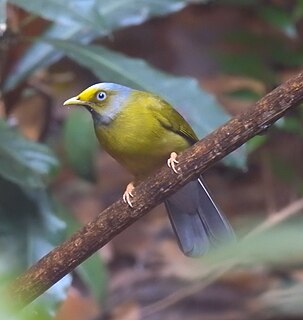 W
WThe grey-headed bulbul is a member of the bulbul family, Pycnonotidae. It is endemic to the Western Ghats in south-western India, and found from Goa south to Tamil Nadu at altitudes up to 1200m. It is found in dense reeds or thickets mainly near rivers and swampy areas inside forests. They have a distinctive call that reveals their presence inside dense vegetation where they are hard to spot.
 W
WThe yellow-browed bulbul, or golden-browed bulbul, is a species of songbird in the bulbul family, Pycnonotidae. It is found in the forests of southern India and Sri Lanka. The yellow-browed bulbul is mainly yellow on the underside and olive above with a distinct yellow brow. They are easily located by their loud calls but tend to skulk within foliage below the forest canopy. While its taxonomic classification has changed over time, it is currently the sole species within the monotypic genus Acritillas which is closely related to Hemixos.
 W
WThe yellow-throated bulbul is a species of songbird in the bulbul family of passerine birds. It is endemic to southern peninsular India. They are found on scrub habitats on steep, rocky hills many of which are threatened by granite quarrying. It is confusable only with the white-browed bulbul with which its range overlaps but is distinctively yellow on the head and throat apart from the yellow vent. The calls of this species are very similar to that of the white-browed bulbul.
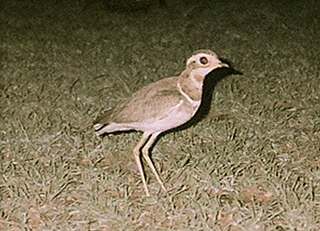 W
WJerdon's courser is a nocturnal bird belonging to the pratincole and courser family Glareolidae endemic to India. The bird was discovered by the surgeon-naturalist Thomas C. Jerdon in 1848 but not seen again until its rediscovery in 1986. This courser is a restricted-range endemic found locally in India in the Eastern Ghats of Andhra Pradesh. It is currently known only from the Sri Lankamalleswara Wildlife Sanctuary, where it inhabits sparse scrub forest with patches of bare ground.
 W
WThe spot-bellied eagle-owl, also known as the forest eagle-owl is a large bird of prey with a formidable appearance. It is a forest-inhabiting species found in the Indian Subcontinent and Southeast Asia. This species is considered part of a superspecies with the barred eagle-owl, which looks quite similar but is allopatric in distribution, replacing the larger spot-bellied species in the southern end of the Malay Peninsula and the larger island in Southeast Asia extending down to Borneo.
 W
WThe rufous-bellied eagle or rufous-bellied hawk-eagle is a bird of prey in the family Accipitridae that is found in the forested regions of tropical Asia. Relatively small for eagles and contrastingly patterned like a falcon, this species was earlier placed in the genus Hieraaetus and sometimes also in the genus Aquila but thought to be distinctive enough to belong to a separate genus.
 W
WThe Nilgiri flowerpecker is a tiny bird in the flowerpecker family. Formerly a subspecies of what used to be termed as the plain flowerpecker although that name is now reserved for Dicaeum minullum. Like others of the group, it feeds predominantly on nectar and fruits. They forage within the canopy of forests and are found in India. They are non-migratory and the widespread distribution range includes several populations that are non-overlapping and morphologically distinct, some of which are recognized as full species. They are important pollinators and dispersers of mistletoes in forests.
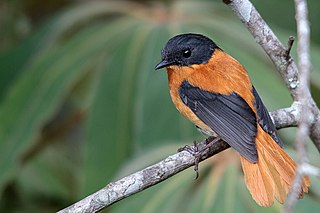 W
WThe black-and-orange flycatcher or black-and-rufous flycatcher is a species of flycatcher endemic to the central and southern Western Ghats, the Nilgiris and Palni hill ranges in southern India. It is unique among the Ficedula flycatchers in having rufous coloration on its back and prior to molecular studies was suggested to be related to the chats and thrushes.
 W
WThe white-bellied blue flycatcher is a small passerine bird in the flycatcher family Muscicapidae. It is endemic to the Western Ghats of southwest India. Males are dark blue with a lighter shade of blue on the brow and have a greyish white belly. Females have a rufous breast, a white face and olive grey above.
 W
WThe Nilgiri flycatcher is an Old World flycatcher with a very restricted range in the hills of southern India. It was formerly referred to as the Nilgiri verditer flycatcher because of its similarity to the verditer flycatcher, a winter migrant to the Nilgiris, which, however, has distinct dark lores and a lighter shade of blue. There are two small white patches at the base of the tail. It is found mainly in the higher altitude shola forests of the Western Ghats and the Nilgiris.
 W
WThe Sri Lanka frogmouth, Sri Lankan frogmouth or Ceylon frogmouth is a small frogmouth found in the Western Ghats of south India and Sri Lanka. Related to the nightjars, it is nocturnal and is found in forest habitats. The plumage coloration resembles that of dried leaves and the bird roosts quietly on branches, making it difficult to see. Each has a favourite roost that it uses regularly unless disturbed. It has a distinctive call that is usually heard at dawn and dusk. The sexes differ slightly in plumage.
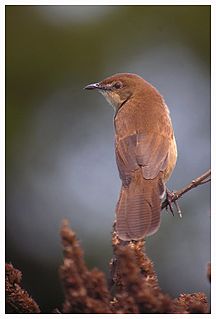 W
WThe broad-tailed grassbird is a species of Old World warbler in the family Locustellidae. It is endemic to the Western Ghats of India with a possibility of occurrence in Sri Lanka. A small, mostly brown bird, it has a broad rounded and graduated tail. It is found only on the higher altitude grassy hills where it usually skulks, except during the breeding season when males fly up into the air to sing in their display. The species is believed to be a resident although it is possible that they make local movements.
 W
WLegge's hawk-eagle is a bird of prey. Like all eagles, it is in the family Accipitridae. It breeds in the Indian subcontinent, from southern India to Sri Lanka. Its specific name kelaarti honors the physician-zoologist E.F. Kelaart.
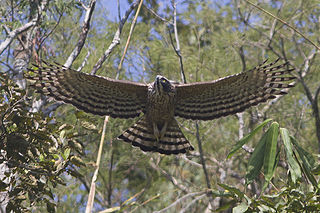 W
WThe mountain hawk-eagle or Hodgson's hawk-eagle, is a large bird of prey native to Asia. The latter name is in reference to the naturalist, Brian Houghton Hodgson, who described the species after collecting one himself in the Himalayas. A less widely recognized common English name is the feather-toed eagle. Like all eagles, it is in the family Accipitridae. Its feathered tarsus marks this species as a member of the subfamily Aquilinae. It is a confirmed breeding species in the northern part of the Indian subcontinent, from India, Nepal through Bangladesh to Thailand, Taiwan and Japan, although its distribution could be wider still as breeding species. Like other Asian hawk-eagles, this species was earlier treated under the genera of Spizaetus but genetic studies have shown this group to be paraphyletic, resulting in the Old World members being placed in Nisaetus and separated from the New World species. As is typical of hawk-eagles, the mountain hawk-eagle is a forest dwelling opportunistic predator who readily varies its prey selection between birds, mammals and reptiles along with other vertebrates. Although classified currently as a least-concern species due its persistence over a rather wide distribution, this species is often quite rare and scarce and seems to be decreasing, especially in response to large-scale habitat degradation and deforestation.
 W
WThe Malayan night heron, also known as Malaysian night heron and tiger bittern, is a medium-sized heron. It is distributed in southern and eastern Asia.
 W
WThe Malabar grey hornbill is a hornbill endemic to the Western Ghats and associated hills of southern India. They have a large beak but lack the casque that is prominent in some other hornbill species. They are found mainly in dense forest and around rubber, arecanut or coffee plantations. They move around in pairs or small groups, feeding on figs and other forest fruits. Their loud cackling and laughing call makes them familiar to people living in the region.
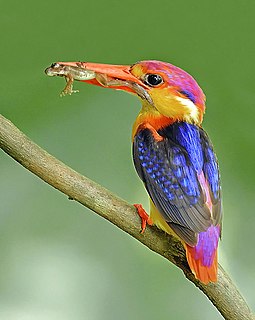 W
WThe oriental dwarf kingfisher, also known as the black-backed kingfisher or three-toed kingfisher, is a pocket-sized bird in the family Alcedinidae. This tropical kingfisher is a partial migrant that is endemic across much of the Indian Subcontinent and Southeast Asia. It resides in lowland forests, typically near streams or ponds, where it feeds upon insects, spiders, worms, crabs, fish, frogs, and lizards. This small bird is easily distinguishable from other birds in its range due to its red bill, yellow-orange underparts, lilac-rufous upperparts, and blue-black back.
 W
WThe Ashambu laughingthrush or Travancore laughingthrush is a species of bird in the family Leiothrichidae. It is found in the Western Ghats in southern Kerala and southern Tamil Nadu. It was formerly considered a subspecies of the grey-breasted laughingthrush. It is closely related to the Palani laughingthrush and can be differentiated from it by its very short white brow that stops before the eye.
 W
WThe Banasura laughingthrush is a species of bird in the family Leiothrichidae. It is found in shola habitat in a small section of the Western Ghats in southwestern Karnataka and northern Kerala. It was formerly considered a subspecies of the black-chinned laughingthrush.
 W
WThe Palani laughingthrush is a species of laughingthrush endemic to the hills of the Western Ghats south of the Palghat Gap in Southern India. Found in the high montane forests, this grey bibbed, rufous bellied bird with a prominent dark eyestripe and broad white brow was grouped along with the grey-breasted subspecies of the black-chinned laughingthrush and known as the grey-breasted laughingthrush. This species is found in the Palni Hills while another closely related form, the Ashambu laughingthrush with a shorter white brow is found in the high hills south of the Achankovil Gap and was treated as a subspecies. The two forms were together treated under the name of Kerala laughingthrush.
 W
WThe Nilgiri laughingthrush is a species of laughingthrush endemic to the high elevation areas of the Nilgiris and adjoining hill ranges in Peninsular India. The mostly rufous underparts, olive brown upperparts, a prominent white eyebrow and a black throat make it unmistakable. It is easily detected by its loud series of nasal call notes and can be hard to spot when it is hidden away inside a patch of dense vegetation. The species has a confusing taxonomic history, leading to a range of names. In the past the species was considered to have two subspecies, the nominate form in the Nilgiris and jerdoni with a grey upper breast and found in the Brahmagiris of Coorg and Banasura range of Wayanad. They are omnivorous, feeding on a range of insects, berries and nectar.
 W
WThe Wayanad laughingthrush is a species of laughingthrush in the family Leiothrichidae. It is endemic to the Western Ghats south of Goa in India. These laughingthrushes move in groups in dense forests, producing loud calls but tend to be hard to spot in the undergrowth. They have brown upperparts, a white throat, a broad black mask through the eye and a heavy bill with pale yellow on the lower mandible. Despite the name, derived from the Wayanad region, this species has a wider range than the four other south Indian species of laughingthrush that are restricted to the higher elevation hills.
 W
WThe black-throated munia or Jerdon's mannikin is a small passerine bird. This estrildid finch is a resident breeding bird in the hills of southwest India, the Eastern Ghats and Sri Lanka.
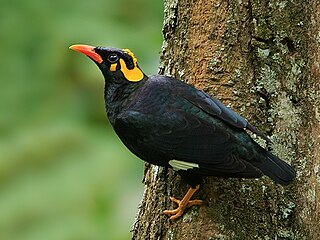 W
WThe southern hill myna is a member of the starling family. It is a resident of southwestern India and Sri Lanka.
 W
WThe brown-backed needletail, or brown needletail, is a large swift.
 W
WThe Sri Lanka bay owl is a species of bay owl in the family Tytonidae. It is endemic to the island of Sri Lanka and the Western Ghats in Kerala, South Western India. It was considered a subspecies of the Oriental bay owl but is now treated as a full species due to its distinctive call, plumage and disjunct distribution.
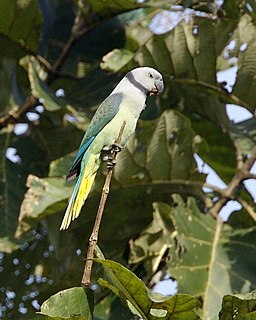 W
WThe blue-winged parakeet, also known as the Malabar parakeet is a species of parakeet endemic to the Western Ghats of southern India. Found in small flocks, they fly rapidly in forest clearings while making screeching calls that differ from those of other parakeet species within their distribution range. Their long blue tails tipped in yellow and the dark wings with blue contrast with the dull grey of their head and body. Adult males and females can be easily told apart from the colour of their beak.
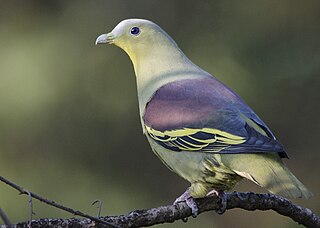 W
WThe grey-fronted green pigeon is a pigeon in the genus Treron. It is found in the forests of the Western Ghats in India. Many authorities have split the species from the pompadour green pigeon complex.
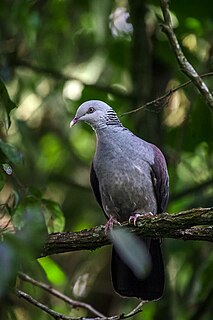 W
WThe Nilgiri wood pigeon is large pigeon found in the moist deciduous forests and sholas of the Western Ghats in southwestern India. They are mainly frugivorous and forage in the canopy of dense hill forests. They are best identified in the field by their large size, dark colours and the distinctive checkerboard pattern on their nape.
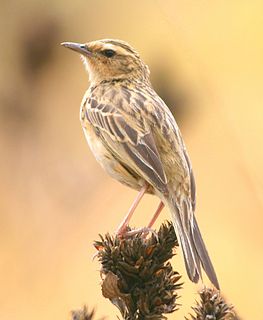 W
WThe Nilgiri pipit is a distinctive species of pipit that is endemic to the high altitude hills of southern India. Richer brown in colour than other pipits in the region, it is distinctive in having the streaking on the breast continuing along the flanks. It is non-migratory and has a tendency to fly into low trees when disturbed and is closely related to the tree pipits Anthus hodgsoni and Anthus trivialis.
 W
WThe little spiderhunter is a species of long-billed nectar-feeding bird in the family Nectariniidae found in the moist forests of South and Southeast Asia. Unlike typical sunbirds, males and females are very similar in plumage. They are usually seen in ones or twos and frequently make a tzeck call and are most often found near flowering plants, where they obtain nectar.
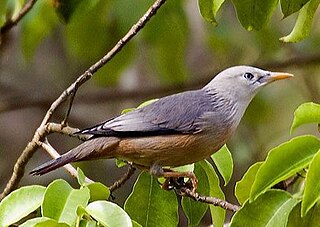 W
WThe Malabar starling is a species of starling found in southwestern India. It was previously considered a subspecies of the chestnut-tailed starling.
 W
WThe crimson-backed sunbird or small sunbird is a sunbird endemic to the Western Ghats of India. Like other sunbirds, they feed mainly on nectar although they take insects, especially to feed their young. They are tiny birds that are resident and are found in forests but are particularly attracted to gardens at the edge of the forest where people grow suitable flower-bearing plants. They usually perch while taking nectar.
 W
WLoten's sunbird, also known as the long-billed sunbird or maroon-breasted sunbird, is a sunbird endemic to peninsular India and Sri Lanka. Named after Joan Gideon Loten, who was the Dutch governor of colonial Ceylon, it is very similar to the purple sunbird that is found in the same areas and also tends to hover at flowers for nectar, but can be distinguished by the longer bill, the maroon band on the breast and brownish wings. Like other sunbirds, it is also insectivorous and builds characteristic hanging nests.
 W
WThe hill swallow is a small passerine bird in the swallow family. It breeds in southern India and Sri Lanka. It is resident apart from some local seasonal movements. This bird is associated with coasts, but is increasingly spreading to forested uplands. It was formerly considered to be a subspecies of the Pacific swallow.
 W
WThe Nilgiri thrush is a member of the thrush family.
 W
WThe Malabar whistling thrush is a whistling thrush in the family Muscicapidae. They are also known locally by the name of whistling schoolboy for the whistling calls that they make at dawn that have a very human quality. The species is a resident in the Western Ghats and associated hills of peninsular India including central India and parts of the Eastern Ghats.
 W
WThe white-bellied treepie is a bird of the crow family endemic to the forests of southern India. They overlap in distribution in some areas with the rufous treepie but are easily to tell apart both from appearance and call.
 W
WThe Malabar trogon is a species of bird in the trogon family. It is found in the forests of Sri Lanka and peninsular India. In India it is mainly found in the Western Ghats, hill forests of central India and in parts of the Eastern Ghats. They are insectivorous and although not migratory, may move seasonally in response to rain in hill forest regions. Like in other trogons, males and females vary in plumage. The birds utter low guttural calls that can be heard only at close quarters and the birds perch still on a branch under the forest canopy, often facing away from the viewer making them easy to miss despite their colourful plumage.